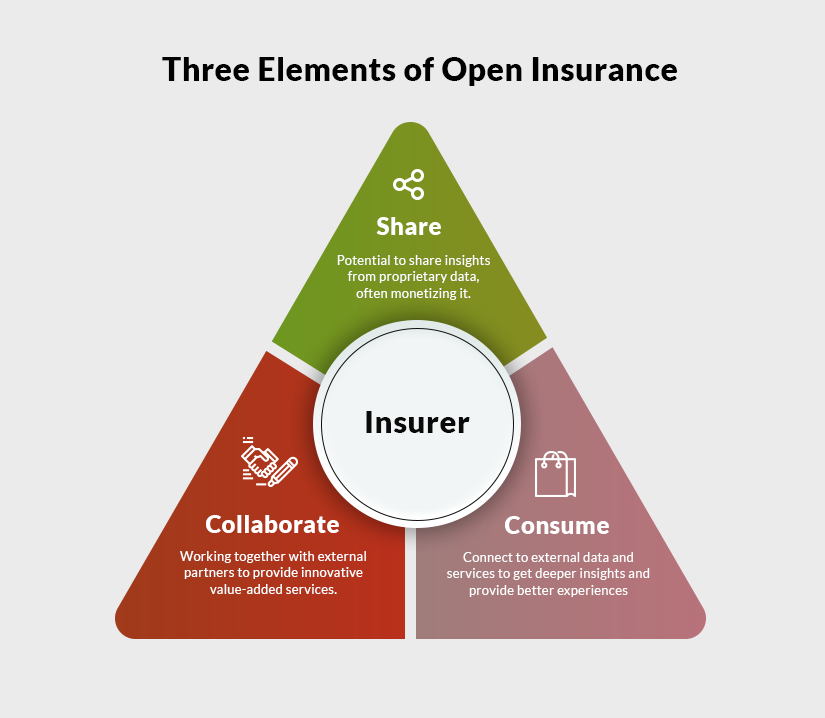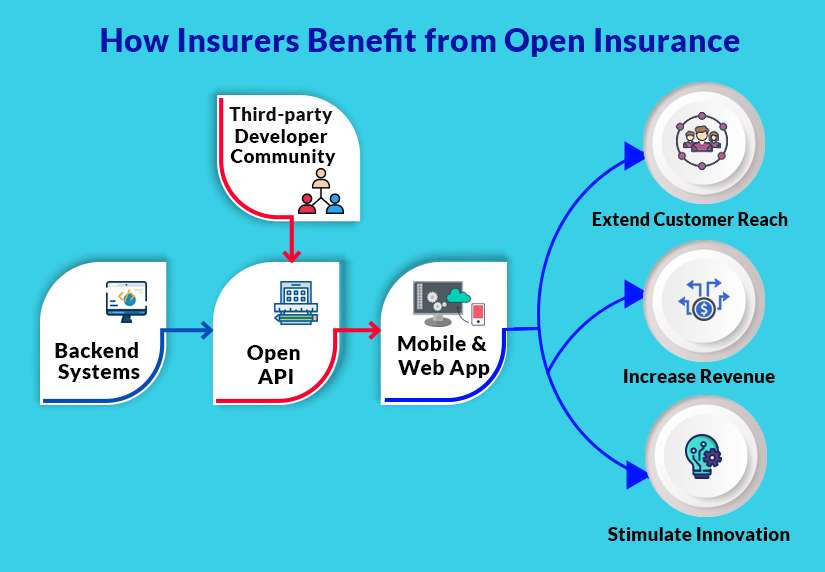How Open Insurance APIs are Fueling a Bullish Shift in Insurance Processes

APIs are a vital component of the ongoing digital transformation within the insurance industry. As insurers embrace the digital age, speed to market is essential. Open Insurance API-enabled platforms enable insurers to seamlessly connect their internal systems with external services, allowing for rapid and cost-effective expansion of their service offerings. This is why we are seeing a rapid increase in API-based insurance use cases.
What is the importance of Open APIs for insurance?
Digital transformation is not just about adopting new technologies; it's about reimagining the entire insurance process. Open APIs play a crucial role in this transformation by enabling insurers to connect with external partners, insurtech startups, and third-party services. An Open API, or Open Application Programming Interface, is an interface that allows different software systems to communicate and interact with each other while adhering to regulations and is often made publicly accessible.
For example, a company’s insurance APIs can integrate with data providers to assess risk more accurately, offer innovative claims processing solutions, or enhance customer experiences with features like chatbots and mobile apps.
Such APi-enabled insurance platform integration facilitates the creation of a more agile, customer-centric, and competitive insurance ecosystem, ultimately benefiting the industry and its policyholders. In essence, APIs are the cornerstone of the digital transformation journey for insurance companies, allowing them to evolve and thrive in a rapidly changing landscape.
According to McKinsey's analysis, as much as 40% of the expenses for property and casualty (P&C) are tied up within their top 20 end-to-end processes. Digitization has the potential to decrease these costs but they require an API-enabled insurance platform.
Open insurance API ecosystems will do for U.S. insurance what it did for banking
‘Open Banking’ started this revolution with unrestricted application programming interfaces (APIs) providing seamless digital customer journeys.
Open insurance is a modern insurance model closely linked to embedded insurance (Offering insurance products on non-insurance platforms). In this approach, insurers enhance their efficiency, revenue, and partnerships by sharing data resources with other organizations. This sharing primarily happens through open insurance APIs, enabling insurers to integrate their products with third-party offerings. This model generates additional revenue sources and fosters stronger relationships across sectors for insurance companies, all while delivering improved and new value-added services to customers.
A robust API ecosystem is a prerequisite for developing flexible platforms that provide hyper-personalized services to customers.
In 2023, insurers demand almost immediate access to extensive data, originating from internal systems such as policy management, as well as external databases. Insurance APIs commonly connect:
-
External systems like data providers and third-party databases such as those offering property records and criminal history
-
Telematics insurance APIs are often provided by third-party telematics service providers that specialize in collecting and analyzing data related to vehicle usage and driving behavior. These third-party telematics providers offer services that go beyond the traditional capabilities of an insurance company.
-
Insurance companies often rely on third-party drone operators to carry out aerial inspections and assessments for claims management, particularly for property and casualty claims. They can be deployed to assess damage in hard-to-reach or hazardous areas, which can significantly expedite the claims process. While the primary focus of using drones in insurance may be claims management, they can also provide valuable data for risk assessment and underwriting. These require the integration of APIs in insurance platforms to communicate seamlessly with external agents.

Also read: Is Your Tech Stack Holding You Back from a Full Digital Transformation?
Open APIs unlocking opportunities
Essentially, insurance API integrations enable easy and quick digital communications. They are the digital adhesive that allows applications in an ecosystem to communicate with each other.
Look at what open APIs have done in other industries. Uber combines multiple API services across sectors like airlines and travel companies to offer swift services to customers. In the process, the ride-hailing company has also boosted its revenue and market capitalization to give automobile behemoths like BMW and Ford a run for their money.
Most modern core platforms are designed with open insurance API integration capabilities, allowing seamless connections with external systems and services. SimpleINSPIRE's forward-thinking API-based architecture empowers its core platform to seamlessly integrate with and harness innovations from insurtech providers. The modern insurance platform facilitates a context-specific, data-driven approach across virtually all aspects of the insurer's operations. This will improve risk management in insurance, create new revenue streams, and take digital customer journeys to the next level.
Open APIs can lead this shift from traditional product-centric models to customer-centric models.
Many older insurance systems are built on legacy technology that predates the API-driven approach that is prevalent today. These legacy systems were not initially designed to communicate with external systems through APIs. Retrofitting older systems to support modern insurance API integration can be costly and complex. It may require substantial development and resources to bring legacy systems up to par with modern capabilities.
Three use cases for open API integration in insurance

1. APIs in insurance: Improved and personalized product offerings
Insurers can harness the power of artificial intelligence (AI) and machine learning to effectively analyze, process, and tailor data for personalized policy offerings and real-time quotes. Key to this process are open insurance APIs, which expedite the secure transfer of data within the ecosystem.
For instance, when a customer seeks auto insurance, an open insurance API integrated with the ecosystem can swiftly access pertinent customer information, generate relevant insurance quotes, and promptly deliver these quotes to the customer. Moreover, it can utilize dynamic risk assessment to create customized offerings that align with the customer's specific needs. A prime example of this tailored approach is the pay-per-mile insurance products that are becoming popular. These are offered by major insurers such as Allstate and Nationwide.
2. Enhanced risk management in insurance
In the property & casualty sector, insurers are harnessing real-time risk data through insurance APIs to evaluate a driver's risk profile. Moreover, property insurance providers are now utilizing real-time data for home protection. By utilizing data generated from the proliferation of smart homes and devices via insurance APIs, insurers can effectively monitor conditions, detect risk alerts, and curtail their loss ratios. Additionally, smart sensors can promptly notify property owners about potential leaks and other threats such as floods or damage to commercial properties.
3. Increase in partner ecosystems across industries
APIs can also encourage ecosystem partnerships among insurers and other businesses. This is a great way for insurance companies to generate new leads and grow their revenue streams. For instance, a P&C insurer can partner with real estate agencies to generate leads for home insurance. Travel insurers can partner with travel companies to provide travelers insurance as part of their travel package. Without open API networks, such integrations would have required a lot of workarounds. Now it’s more of no business is an island, we have data that you can use and vice versa.
Travelsafe has increased its insurance distribution network by allowing travel agents to register as affiliates. Each affiliate gets a personalized URL that they share with their clients and when their clients sign up, the affiliate gets a commission. How simple is that idea? And how far-reaching is the result.
Through mutual understanding of needs, transactional values and impactful interactions, APIs can quickly scale partnerships.
Also read: What’s Keeping Insurers from Using Insurtech More Effectively?
The future of insurance
Open insurance facilitated via a free API ecosystem is poised to push insurance beyond traditional models. It can transform digital journeys, foster collaborations, improve risk management and insurance, and generate innovative revenue streams.
“If your enterprise has not started strategizing and planning for business APIs, the time is now. Do not wait until you know all the answers and have everything in place to get started; the market is moving too fast.” – IBM
Looking to leverage open ecosystems and microservices architecture in insurance? SimpleSolve’s Enterprise Insurance Solutions are here to give you whatever you need. Our multi-line insurance platform is flexible, scalable, and built for the new insurance era. Talk to us today.
Topics: Digital Ecosystems







.jpg)
